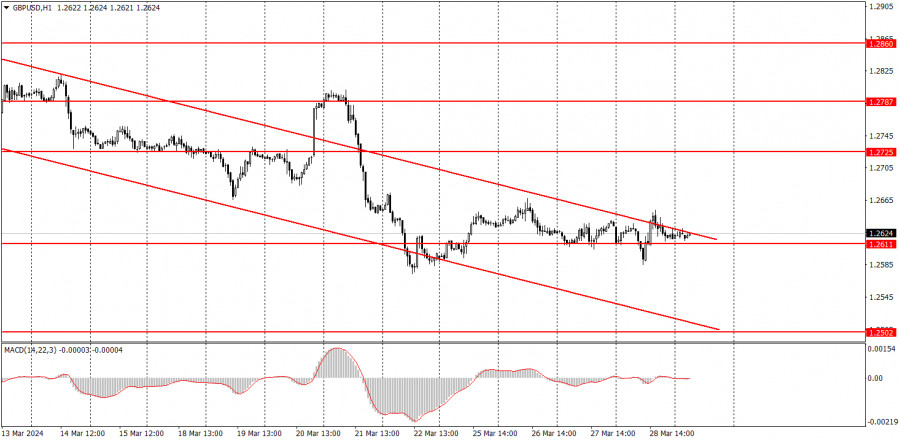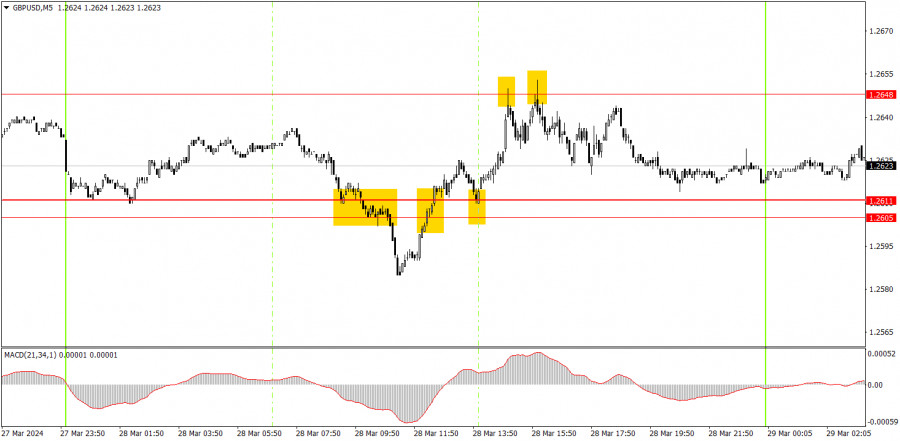Analyzing Thursday's trades:
GBP/USD on 1H chart
The GBP/USD pair showed a flat phase on Thursday. Even on the hourly chart, it's clear that the price has been trading along the 1.2611 level for the fifth consecutive day, ignoring the level itself. Such movement only leads to false signals, as not only is the volatility quite low, but the pair is also moving sideways. This is the worst combination of factors. Now there's no doubt that the price will leave the descending channel, and this exit will be meaningless. After that, the price could resume its decline, continue the flat movement, or start to rise. After all, the British pound remains within the sideways channel on the 24-hour timeframe. Now we're seeing a flat phase on almost all charts. For 4 months, the price cannot break out of the 1.25-1.28 range.
There was no news in the UK yesterday, while the US GDP report came out stronger than expected (+3.4%), the initial jobless claims report was stronger than expected, and the University of Michigan's Consumer Sentiment Index was stronger than expected. Therefore, it would have been logical for the dollar to rise. But it didn't, which isn't even surprising anymore.
GBP/USD on 5M chart
Several trading signals were generated on the 5-minute timeframe. Initially, the pair settled below the 1.2605-1.2611 area but failed to fall by 20 pips. Then the pair suddenly started to correct higher, which disrupts the downward movement. After that, the pair settled above the 1.2605-1.2611 area and tested the level of 1.2648. Traders cold have earned approximately 15 pips with the second trade. Rebounds from the 1.2648 level should also have been used for opening positions (for selling), and beginners could earn another 10-15 pips.
Trading tips on Friday:
On the hourly chart, the downtrend persists. Unfortunately, the market continues to trade in an illogical and sluggish way, and recently, it has been mostly moving sideways. Nevertheless, the British currency has been gradually declining, which is somewhat encouraging. The movements are currently very chaotic, with little logic behind them.
Today, we will expect signals around the 1.2605-1.2611 area. We can either work with rebounds from it or wait for the price to overcome them, which might slightly strengthen the current movement and trigger a new decline. Nevertheless, we're talking about very weak movements.
The key levels on the 5M chart are 1.2372-1.2387, 1.2457, 1.2502, 1.2544, 1.2605-1.2611, 1.2648, 1.2691, 1.2725, 1.2787-1.2791, 1.2848-1.2860, 1.2913, 1.2981-1.2993. There are no important events scheduled in the UK. The US docket will feature secondary reports on Personal Consumption Expenditures Prices, Personal Income, and Personal Spending. In addition, Federal Reserve Chief Jerome Powell will deliver an important speech, but it will occur late in the evening and will not influence the pair's movement during the day.
Basic trading rules:
1) Signal strength is determined by the time taken for its formation (either a bounce or level breach). A shorter formation time indicates a stronger signal.
2) If two or more trades around a certain level are initiated based on false signals, subsequent signals from that level should be disregarded.
3) In a flat market, any currency pair can produce multiple false signals or none at all. In any case, the flat trend is not the best condition for trading.
4) Trading activities are confined between the onset of the European session and mid-way through the U.S. session, after which all open trades should be manually closed.
5) On the 30-minute timeframe, trades based on MACD signals are only advisable amidst substantial volatility and an established trend, confirmed either by a trendline or trend channel.
6) If two levels lie closely together (ranging from 5 to 15 pips apart), they should be considered as a support or resistance zone.
How to read charts:
Support and Resistance price levels can serve as targets when buying or selling. You can place Take Profit levels near them.
Red lines represent channels or trend lines, depicting the current market trend and indicating the preferable trading direction.
The MACD(14,22,3) indicator, encompassing both the histogram and signal line, acts as an auxiliary tool and can also be used as a signal source.
Significant speeches and reports (always noted in the news calendar) can profoundly influence the price dynamics. Hence, trading during their release calls for heightened caution. It may be reasonable to exit the market to prevent abrupt price reversals against the prevailing trend.
Beginners should always remember that not every trade will yield profit. Establishing a clear strategy coupled with sound money management is the cornerstone of sustained trading success.












